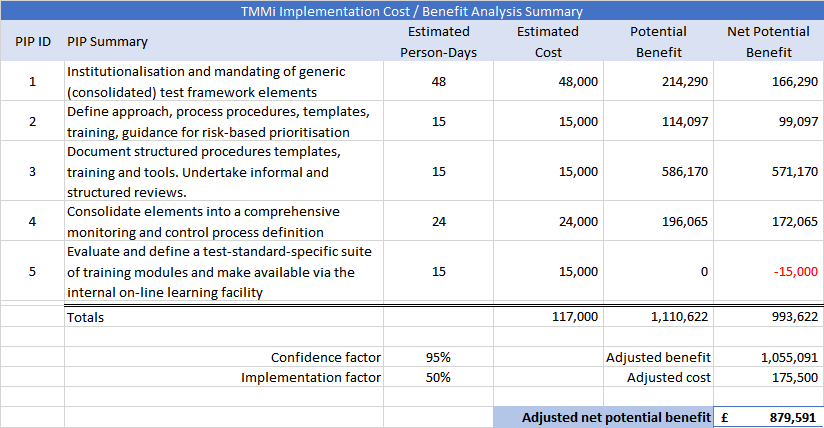In this third blog, we look in more detail about how return on investment (ROI) for a test process improvement initiative can be calculated.
There are numerous ways of working out the potential, and actual, financial benefits of implementing test process improvements. Here we show one way, based on the method Experimentus uses and for a TMMi driven initiative.
Below is an example of a spreadsheet used to help calculate and document the costs and benefits for a project improvement plan (PIP) for a real client:

- For each area of improvement, we estimate how many person-days we believe it will take to make the improvement.
- We then agree with the client what the estimated average cost of a person day should be
- This will include both the client’s resource costs and Experimentus’ resource costs – dependent on our level of involvement.
- These are then used to calculate the estimated cost of implementation. Here we have estimated £1,000 per day.
- We then calculate the anticipated benefit, and, by subtracting the cost, we can estimate the net potential benefit for each of the activities.
In the table above, for PIP ID 5, you can see that we have an improvement with a potential benefit of zero against it. Often we find that there are some improvements for which there are no financial benefit. The benefit they do provide is that they are foundation stones for the other changes. If these are not implemented, the benefits of the other changes would not be delivered.
These items still need to be in the costings, and as long as the overall calculation still demonstrates a sufficient benefit, there is not an issue. The advantage is that by including these zero-benefit items with the positive-amount benefits, the overall cost of the implementation is fully understood.
The above is an example of a potential benefits summary where there is positive value-add to the business.
We have included a confidence factor (in other words, how confident we are that the benefits will be realised) which can be adjusted to each situation. The implementation factor (how much could implementation costs vary from the amount originally estimated) can be positive or negative.
For this example, from experience with this particular client, we have estimated an extra 50% could be needed. The final net potential benefit is calculated by subtracting the adjusted cost from the adjusted benefit.
We hope you enjoyed this series of blogs on the need for and benefits of test process improvement. It can be difficult to justify a test process improvement initiative, but it will provide a lot of benefit, both direct and indirect. For more information on how we can help you, please take a look at our test process improvement page and feel free to contact us.


